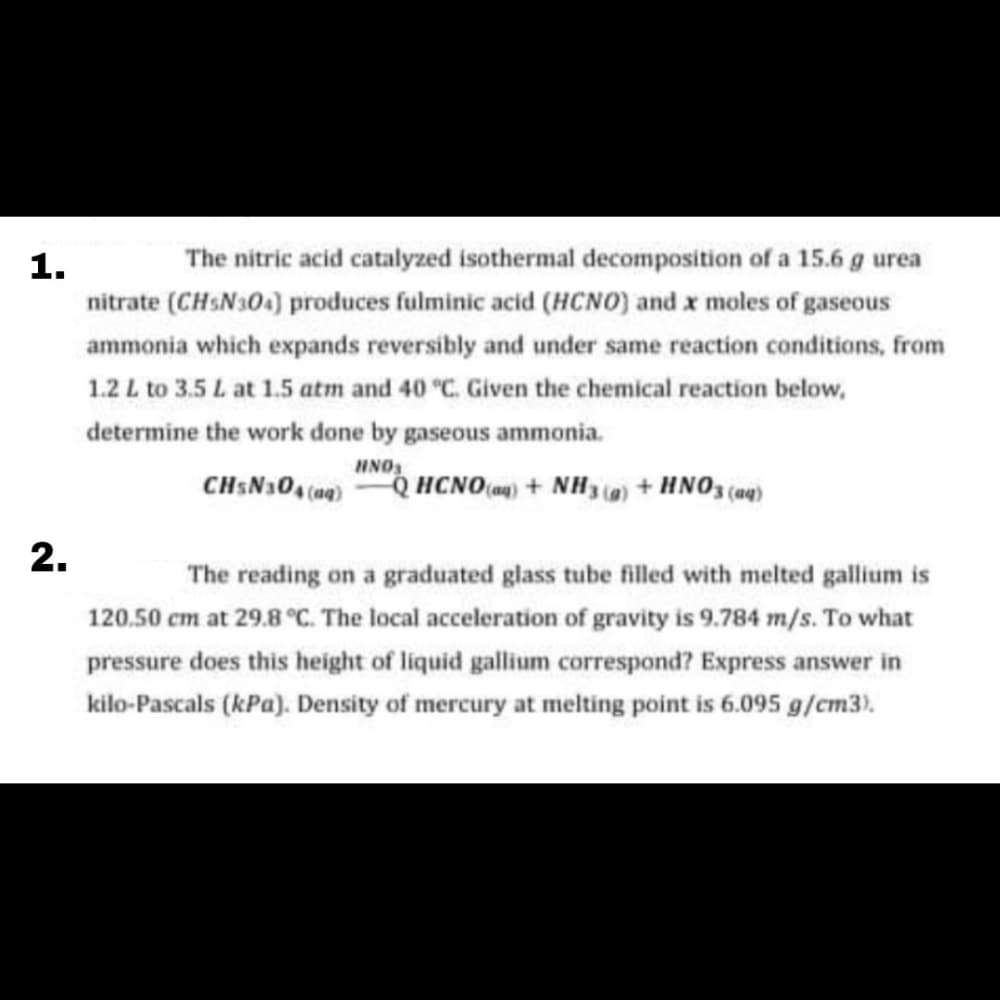The reading on a graduated glass tube filled with melted gallium is 120.50 cm at 29.8 °C. The local acceleration of gravity is 9.784 m/s. To what pressure does this height of liquid gallium correspond? Express answer in kilo-Pascals (kPa). Density of mercury at melting point is 6.095 g/cm3).
The reading on a graduated glass tube filled with melted gallium is 120.50 cm at 29.8 °C. The local acceleration of gravity is 9.784 m/s. To what pressure does this height of liquid gallium correspond? Express answer in kilo-Pascals (kPa). Density of mercury at melting point is 6.095 g/cm3).
Physical Chemistry
2nd Edition
ISBN:9781133958437
Author:Ball, David W. (david Warren), BAER, Tomas
Publisher:Ball, David W. (david Warren), BAER, Tomas
Chapter2: The First Law Of Thermodynamics
Section: Chapter Questions
Problem 2.24E: Calculate the work donewhen 1.000 mole of an ideal gas expands reversiblyfrom 1.0L to 10L at 298.0K....
Related questions
Question
Answer only NUMBER TWO.
Thank you!

Transcribed Image Text:1.
The nitric acid catalyzed isothermal decomposition of a 15.6 g urea
nitrate (CHSN304) produces fulminic acid (HCNO) and x moles of gaseous
ammonia which expands reversibly and under same reaction conditions, from
1.2 L to 3.5 L at 1.5 atm and 40 °C. Given the chemical reaction below,
determine the work done by gaseous ammonia.
HNOS
CHSN10, (me) Q HCNO(a) + NH3n + HNO3 (au)
2.
The reading on a graduated glass tube filled with melted gallium is
120.50 cm at 29.8 °C. The local acceleration of gravity is 9.784 m/s. To what
pressure does this height of liquid gallium correspond? Express answer in
kilo-Pascals (kPa). Density of mercury at melting point is 6.095 g/cm3).
Expert Solution
This question has been solved!
Explore an expertly crafted, step-by-step solution for a thorough understanding of key concepts.
Step by step
Solved in 2 steps with 1 images

Knowledge Booster
Learn more about
Need a deep-dive on the concept behind this application? Look no further. Learn more about this topic, chemistry and related others by exploring similar questions and additional content below.Recommended textbooks for you

Physical Chemistry
Chemistry
ISBN:
9781133958437
Author:
Ball, David W. (david Warren), BAER, Tomas
Publisher:
Wadsworth Cengage Learning,

Principles of Modern Chemistry
Chemistry
ISBN:
9781305079113
Author:
David W. Oxtoby, H. Pat Gillis, Laurie J. Butler
Publisher:
Cengage Learning

Chemistry: The Molecular Science
Chemistry
ISBN:
9781285199047
Author:
John W. Moore, Conrad L. Stanitski
Publisher:
Cengage Learning

Physical Chemistry
Chemistry
ISBN:
9781133958437
Author:
Ball, David W. (david Warren), BAER, Tomas
Publisher:
Wadsworth Cengage Learning,

Principles of Modern Chemistry
Chemistry
ISBN:
9781305079113
Author:
David W. Oxtoby, H. Pat Gillis, Laurie J. Butler
Publisher:
Cengage Learning

Chemistry: The Molecular Science
Chemistry
ISBN:
9781285199047
Author:
John W. Moore, Conrad L. Stanitski
Publisher:
Cengage Learning

Chemistry: Principles and Practice
Chemistry
ISBN:
9780534420123
Author:
Daniel L. Reger, Scott R. Goode, David W. Ball, Edward Mercer
Publisher:
Cengage Learning

Chemistry: An Atoms First Approach
Chemistry
ISBN:
9781305079243
Author:
Steven S. Zumdahl, Susan A. Zumdahl
Publisher:
Cengage Learning

Chemistry
Chemistry
ISBN:
9781305957404
Author:
Steven S. Zumdahl, Susan A. Zumdahl, Donald J. DeCoste
Publisher:
Cengage Learning